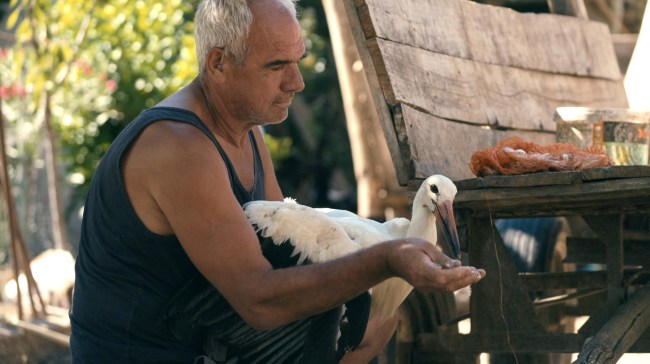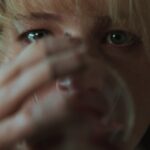“The Tale of Silyan” (see trailer below) is easily the most beautiful documentary of the year, an incredibly thought-provoking non-fiction account of the relationship between an elderly man in North Macedonia and a stork he befriends from a rubbish heap. Nikola desperately tries to hang on to his family farm after his family leaves him to find more permanent work in Germany, and the stork becomes his companion.
It’s a real-life incident strikingly similar to a centuries-old Macedonian folktale about a prodigal son who finds a relationship with his father again only after he’s turned into a stork. But it was never a director Tamara Kotevskas (“Honeyland”) intention to find a real version of “The Tale of Silyan.” Life, closely observed by her for several years in this casejust happened to mirror art.
In fact, Kotevska followed Nikola’s family for a year and a half before the stork Nikola befriended came into the picture. She thought she was just making a documentary about how globalization caused mass immigration… which intersected with her interest in the migration patterns of her homeland’s beloved storks. After Nikola’s stork entered his life, she continued filming for another year. The result is a glimpse of the eternal, a glimpse of how the myths we tell contain deep, transcendent truths that remain relevant through the ages.
Watch the trailer for “The Tale of Silyan” below, then read on for a short interview with Kotevska.
IndieWire: How did you find Nikola and his family, to even make them the subject of your documentary?
Tamara Kotevska: The storks led us to them. I had been interested in how farms turned into landfills had changed where storks got their food, and how that changed their migration patterns. And while we were filming this, we did a lot of footage of storks eating from people’s lands and farmland. So they introduced us to the families that were farming and one of those families was Nikola’s family, and we loved them, and we decided to stick with his family and continue to follow them.
As a Macedonian, was the “Tale of Silyan” itself, the actual myth or fairy tale legend of a father and his son who became a stork, something you grew up with? Was there something that was part of your family heritage passed down that you were aware of from childhood?
Yes, absolutely. This is the first story I ever heard in my life from my grandparents. It is a very popular fairy tale. It’s like Snow White or Little Red Riding Hood. It is so popular in Macedonia. But I never planned to use it until I realized the connection and the locals started making fun of Nikola. “Oh, it’s Silyan. It’s the stork from the story.” So it became like a joke, but then I realized when I went back to the story that it actually has a deeper meaning, so let’s try to use it in a modern context and recycle this story.
There are scenes of such intimacy in this documentary that it’s amazing you happened to be there to capture them. I’m thinking of the moment when you actually catch Nikola and his wife on Facetime and his kids ask his wife to come with them to Germany… which means Nikola will be all alone in Macedonia. How was it even possible to catch?
It is a combination of research, very thorough research, to the point where you as a documentary filmmaker can also predict certain things. Just like when you’re recording nature, you’re doing biological research on the nature and the animal you’re following, and somehow you can predict where, in what areas it will happen to eat or sleep or just things like that.
When you live with a subject, and I always want to spend the time living with my subjects, that’s my only rule really. So I spend a lot of time in their house. We actually also slept in their house and spent time there. So I want to observe their reality, I want to be their friend, to understand what is happening in life. So I can kind of predict moments, dramatic moments, that are about to happen, like even the protests (pictured in film).
This particular moment (when Nikola realized he was going to be completely left), there were a lot of moments like this beforehand that didn’t actually make the cut because they’re a very open family that talks openly about things and they didn’t just care about the camera being there. And this conversation was actually mentioned many times, not just once because the daughter kept calling and complaining about how hard life is there (in Germany). So it was kind of an iterative conversation that we just picked this particular one, but it was an ongoing issue.
So much of this film is about how we are not in control, how humans, like animals, are subject to forces almost beyond our understanding that control our lives. Such as the market forces that forced Nikola’s family to seek a different life elsewhere. Or the animal instinct that controls the storks’ migration patterns.
This is one reason why I love mythology and myths and folktales because they hold the knowledge that we cannot lose. They seem irrelevant today, but actually they are very relevant because our ancestors came to certain conclusions and they wanted to transmit their knowledge and their conclusions through myths, and they added magic to it so that it catches people’s attention.
In a way, that’s what we do today with film. We find creative ways to send a message. And the wider we can spread it and grab people’s attention creatively, the better they can get information about a particular danger of our time. So I really think it’s important to recover this kind of ancient knowledge and lost knowledge and mythology because it’s always been in human history that new generations learned from the old. It is only in today’s time that new generations feel a bit smarter than the old ones and try to live in a certain way or embrace certain modern knowledge and concepts, like leaning towards AI and internet, which turns out to be unsustainable. This is why I am so interested and committed to exploring these indigenous cultures that are dying out.
National Geographic releases “The Tale of Silyan” in theaters Friday, November 28.







